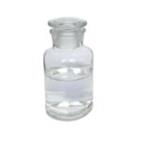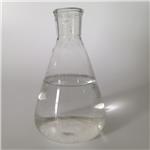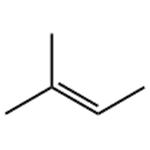Description
2-Methyl-2-butene (also named as Amylene) is an alkene hydrocarbon with the molecular formula C5H10. It is a colorless to pale yellow clear liquid. It can be used as a free radical scavenger in trichloromethane and dichloromethane. It was used for the alkylation of 3-methylthiophene over a zeolitic catalyst. It was also used as a precursor of peroxyacetyl nitrate for calibration purpose.
Chemical Properties
2-Methyl-2-butene is a colorless volatile liquid with unpleasant odour (detection limit ca. 2 ppt) . soluble in alcohol, ether, benzene, insoluble in water. It is used in organic synthesis, hydrogenation, halogenation, alkylation, condensation reactions.
Uses
2-Methyl-2-butene is used to prepare 3-Brom-2.3-dimethyl-1.1-dicyan-butan in the presence of 2,2'-azobis-(2,4-dimethyl-4-methoxyvaleronitrile) as a catalyst. It may be employed as precursor for peroxyacetyl nitrate for the calibration purposes.
Preparation
2-methyl-2-butene is prepared by dehydration of tert-amyl alcohol in presence of p-toluenesulfonic acid or distillation of a catalytically cracked gasoline stream, followed by extraction with aqueous sulfuric acid at low temp.
Definition
ChEBI: 2-Methyl-2-butene is an alkene that is ethylene in which three of the hydrogens are replaced by methyl groups.
General Description
2-methyl-2-butene appears as a clear colorless liquid with a petroleum-like odor. Less dense than water and insoluble in water. Hence floats on water. Vapors heavier than air.
Air & Water Reactions
Highly flammable. Insoluble in water.
Reactivity Profile
2-Methyl-2-butene may react vigorously with strong oxidizing agents. May react exothermically with reducing agents to release gaseous hydrogen. In the presence of various catalysts (such as acids) or initiators, may undergo exothermic polymerization reactions.
Hazard
Highly flammable, dangerous fire and
explosion risk.
Health Hazard
Inhalation or contact with material may irritate or burn skin and eyes. Fire may produce irritating, corrosive and/or toxic gases. Vapors may cause dizziness or suffocation. Runoff from fire control or dilution water may cause pollution.
Purification Methods
Distil amylene and collect the distillate at low temperature. It has also been distilled from sodium. FLAMMABLE. It is available in steel cylinders and has a short
Research
2-Methyl-2-butene is a trisubstituted olefin. It acts as guest and forms stable solid host-guest complexes with self-assembled benzophenone bis-urea macrocycles. The impact of active chlorine on photo-oxidation of 2-methyl-2-butene was studied. Photosensitized oxidation of 2-methyl-2-butene adsorbed on internal framework of Na-ZSM-5 zeolite was studied. Gas-phase reaction of 2-methyl-2-butene with ozone has been investigated. Kinetics of liquid-phase alkylation of 3-methylthiophene with 2-methyl-2-butene on supported phosphoric acid has been reported.
Toxics Screening Level
The initial threshold screening level (ITSL) for amylene (also called 2-methyl-2-butene) is 106 μg/m3 (annual averaging time).
References
Virginie Bellière, Christophe Geantet, Michel Vrinat, Younès Ben-Taarit, Yuji Yoshimura, Alkylation of 3-Methylthiophene with 2-Methyl-2-butene over a Zeolitic Catalyst, Energy & Fuels, 2004, vol. 18, pp. 1806-1813
D. Grosjean, Gas-phase reaction of ozone with 2-methyl-2-butene: dicarbonyl formation from Criegee biradicals, Environmental Science & Technology, 1990, vol. 24, pp. 1428-1432









